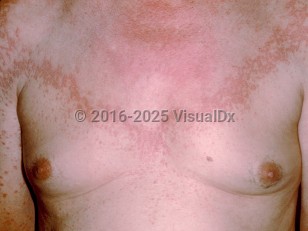Generalized granuloma annulare in Child
Alerts and Notices
Important News & Links
Synopsis

In contrast to other variants of granuloma annulare, the generalized form has a bimodal distribution, predominantly affects children younger than 10 years and adults older than 40 years, has a more prolonged course, and is more resistant to treatment. Granuloma annulare does not favor any particular ethnicity or region. Disseminated disease occurs in approximately 15% of patients with granuloma annulare, with a greater incidence in females than males.
Although the etiology of granuloma annulare is poorly understood, there are rare reports of associations with infections, systemic diseases, hematologic malignancies, and solid tumor malignancies. In particular, hypothesized infectious associations are tuberculosis, HIV, Epstein-Barr virus, hepatitis B and C virus, and herpes zoster virus. Systemic diseases reported to have a connection with granuloma annulare are diabetes mellitus (see type 1, type 2) and thyroid disease. Chronic stress has been reported as a trigger. There have also been cases of granuloma annulare following trauma or insect bites. Familial cases have led to the hypothesis of an association with specific human leukocyte antigen (HLA) phenotypes. While these factors all may be initiators of granuloma annulare, the mechanism of lesion formation has many possibilities. Current hypotheses include a delayed-type hypersensitivity reaction, a cell-mediated immune response, a cytokine-mediated breakdown of connective tissue, or a primary degeneration of connective tissue with an ensuing granulomatous inflammation.
Codes
L92.0 – Granuloma annulare
SNOMEDCT:
402364005 – Generalized granuloma annulare
Look For
Subscription Required
Diagnostic Pearls
Subscription Required
Differential Diagnosis & Pitfalls

Subscription Required
Best Tests
Subscription Required
Management Pearls
Subscription Required
Therapy
Subscription Required
Drug Reaction Data
Subscription Required
References
Subscription Required
Last Updated:10/15/2020

